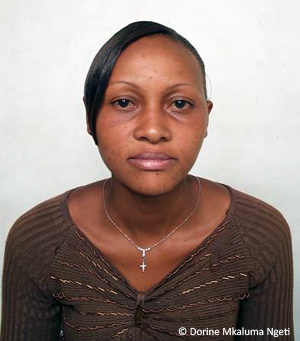My Name is Dorine Mkaluma Ngeti. I pursued Bachelor of Science Environmental Science in Egerton University, Kenya. I have worked with the East African Wild Life Society (EAWLS) Office in Taita for a period during which I was involved in several activities on biodiversity conservation that bring direct benefits to the community – such as nature-based enterprise like butterfly farming, bee-keeping, and sericulture (silkworm rearing) projects, whose aim is the conservation of the natural forests by providing alternative sources of livelihood while generating support and a positive attitude towards their conservation among others. I was also exposed to issues related to community-based development as all the activities revolved around conservation and the community.
Fig1: Demonstration of butterfly surveying session in Mbololo forest which contains some of the largest Indigenous trees in Taita
Other activities include forest connectivity modeling during which period a workshop was held to discuss the recommendations obtained from the model for Taita hills forests. This was all aimed at enhancing the survival of the endangered plant and animal species prominent among them being the Taita thrush (Turdus helleri). Studies on this bird had shown that the sub-population in Chawia forest had experienced a genetic-bottleneck due to isolation and degradation of its habitat, and its long-term survival depended on the creation of stepping stones or corridors between the forest patches where the other sub-populations are. I was also involved in the pilot study on developing a strategy for increasing indigenous tree cover on the farms through the domestication and commercialization of African plum trees (Prunus africana). An extract from the bark from this tree is used in the manufacture of drugs for the treatment/management of prostate cancer in men.
The exposure I received from this opened my eyes to the possibilities and opportunities in the conservation world towards improving the lives of the community while contributing towards environmental conservation. The work being carried out by EAWLS was contributing directly at the local level towards the achievement of the first and the seventh Millennium Development Goals – Eradicate extreme poverty and hunger and Ensure environmental sustainability, respectively.
Fig 2: Collection of food plants for the pilot study of the papilio species of butterflies
Am now working in Taita Taveta Wildlife Forum (TTWF) where the efforts are geared towards the conservation of the Critically Endangered Caecilian in Sagalla, the activities to be carried out are very much related to what was being undertaken in Taita hills by EAWLS. Currently, the office is involved in the preparation of three Participatory Forest Management Plans covering five forest patches as a preparatory step towards their rehabilitation to indigenous forest cover. They are also involved in the preparation of Sub–Catchment Management plans and formation of Water Resource Users Associations for all the sub-catchment areas identified in Taita District and their implementation. This involves the implementation of Lower Voi river/Sagalla Sub-catchment management plan. Several Awareness creation meetings have been held where sensitization messages which include the need to conserve the catchment areas and the environment, biodiversity conservation aspects, provision of community participation in the water and forest acts, tree nurseries and tree planting are discussed. There is also sensitization on tree seedlings production where the nurseries will be identified after the public meetings in Sagalla location which is the main target area for restoration of Sagalla Hill with a view to creating a sustainable future for the Critically Endangered Sagalla caecilian (Boulengerula niedeni).
Fig 3: Sagalla caecilian (Boulengerula niedeni)
Soil erosion and the large stand of exotic Eucalyptus trees are the major impediments to the long-term survival of the Sagalla caecilian and the future of this species therefore rests in the reduction of soil erosion and replacement of existing Eucalyptus with indigenous trees, providing a permanent reserve for this Critically Endangered amphibian. Stabilization of soil can be made through better agricultural practice and strategic forested patches.
This would therefore give me a very strategic opportunity to further develop or build my skills in environmental and biodiversity conservation with community as the centre of focus. Being a local person, it also gives the challenge to ensure that I contribute towards the conservation of the environment in Taita District and more so to ensure these unique organisms continue to persist. I would therefore ask for your support towards implementation of this project.



